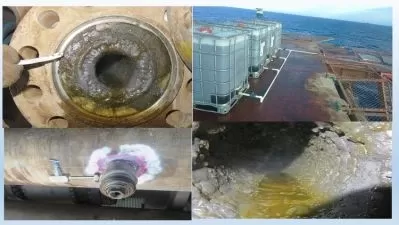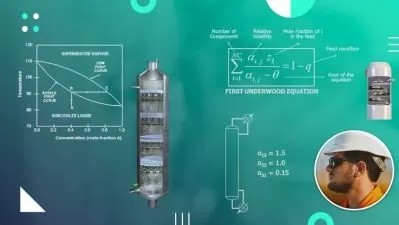Oil and Gas Separation Design
Chemical Engineering University
4:07:35
Description
Only Course for Vertical and Horizontal Separator Sizing with API 12J Considerations
What You'll Learn?
- Principles of Separation Theory
- Separation Mechanisms
- Phase Diagrams
- Vapor-Liquid Equilibrium Theory and Calculations
- Raoult's Law and Antonie Equation
- Bubble and Dew Point Calculations
- Flash Calculations
- Classification of Gravity Separators
- Internal Structure of Separators
- Separator Internals (Inlet Device, Mist Extractor, Vortex Breaker, etc.)
- Separator Design (API 12J Process Considerations)
- Vertical Separator Design
- Horizontal Separator Design
- Common Separator Design Errors
- Operating Challenges in Gravity Separation
Who is this for?
What You Need to Know?
More details
DescriptionThe Oil and Gas Separation Design training course is designed to provide the harmony of theoretical knowledge behind oil and gas separation principles and practical guidelines (specifically, API 12J) for vertical and horizontal separator design.
Oil and gas separation is a common technique in upstream oil and gas wells, where crude oil and natural gas are often found in the same well. Oil and natural gas have different density levels, so mixing them together can cause problems down the road. Oil and gas separation allows for these two products to be distinct from one another. Process equipment companies in the oil and natural gas industry use a number of equipment units designed to separate, or "separate," crude oil from fluids involved in the production of oil. Oil and gas separation is done by physical means, not chemical means.
The training course goes over the following topics, in 40 lectures and 5 practice sessions with 4 hours of video training material:
Principles of Separation Theory
Separation Mechanisms
Phase Diagrams
Vapor-Liquid Equilibrium Theory and Calculations
Raoult's Law and Antonie Equation
Bubble and Dew Point Calculations
Flash Calculations
Classification of Oil and Gas Separators
Internal Structure of Separators
Separator Internals (Inlet Device, Mist Extractor, Vortex Breaker, etc.)
Separator Design (API 12J Process Considerations)
Vertical Separator Design
Horizontal Separator Design
Common Separator Design Errors
Operating Challenges in Gravity Separation
The above essential topics have clearly been discussed during the course. This training can be really helpful for students, engineers, and even teachers aiming to deliver the essentials of multicomponent distillation from the engineering point of view. By spending only 4 hours, you can really understand the whole topic and further do practical calculations.
The course instructor does also provide the service of answering questions for all course participants for free.
Who this course is for:
- Engineers working with Oil and Gas Separators
- Process Engineers
- Chemical Engineers
- Chemical Process Engineering Graduates or Undergraduates
- Any Discipline Engineers Aiming to Learn Essentials of Vertical and Horizontal Separator Sizing
The Oil and Gas Separation Design training course is designed to provide the harmony of theoretical knowledge behind oil and gas separation principles and practical guidelines (specifically, API 12J) for vertical and horizontal separator design.
Oil and gas separation is a common technique in upstream oil and gas wells, where crude oil and natural gas are often found in the same well. Oil and natural gas have different density levels, so mixing them together can cause problems down the road. Oil and gas separation allows for these two products to be distinct from one another. Process equipment companies in the oil and natural gas industry use a number of equipment units designed to separate, or "separate," crude oil from fluids involved in the production of oil. Oil and gas separation is done by physical means, not chemical means.
The training course goes over the following topics, in 40 lectures and 5 practice sessions with 4 hours of video training material:
Principles of Separation Theory
Separation Mechanisms
Phase Diagrams
Vapor-Liquid Equilibrium Theory and Calculations
Raoult's Law and Antonie Equation
Bubble and Dew Point Calculations
Flash Calculations
Classification of Oil and Gas Separators
Internal Structure of Separators
Separator Internals (Inlet Device, Mist Extractor, Vortex Breaker, etc.)
Separator Design (API 12J Process Considerations)
Vertical Separator Design
Horizontal Separator Design
Common Separator Design Errors
Operating Challenges in Gravity Separation
The above essential topics have clearly been discussed during the course. This training can be really helpful for students, engineers, and even teachers aiming to deliver the essentials of multicomponent distillation from the engineering point of view. By spending only 4 hours, you can really understand the whole topic and further do practical calculations.
The course instructor does also provide the service of answering questions for all course participants for free.
Who this course is for:
- Engineers working with Oil and Gas Separators
- Process Engineers
- Chemical Engineers
- Chemical Process Engineering Graduates or Undergraduates
- Any Discipline Engineers Aiming to Learn Essentials of Vertical and Horizontal Separator Sizing
User Reviews
Rating
Chemical Engineering University
Instructor's Courses
Udemy
View courses Udemy- language english
- Training sessions 40
- duration 4:07:35
- Release Date 2023/09/10
















